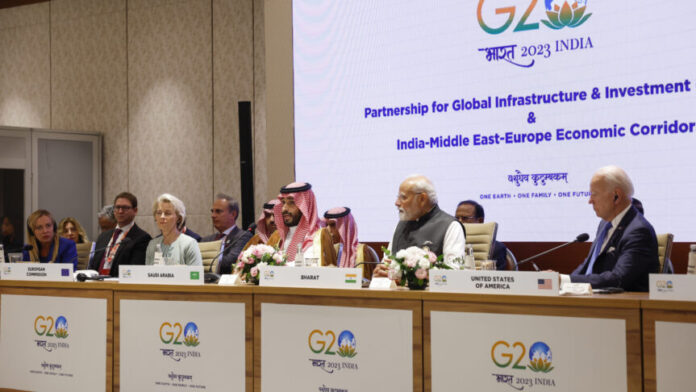Another aren
The India-Middle East-Europe Economic Corridor (IMEC) is a new plan of the USA and its allies, which was announced in the G20 leaders summit. The project was launched to stop the Chinese rise in the region.
If the project is completed, it will ultimately harm China’s Belt and Road Initiatives. The BRI is a massive project of China which has been interlinked with at least three continents. The IMEC is a transitional rail and shipping route spread across two continents, which is a product of the USA and India and will play the role of mediator.
The USA expects that launching this project will energize economic development through connectivity and economic integration between Asia, Europe and the Arabian Gulf. US President Joe Biden, in his visit to Vietnam, told a reporter that the USA did not need to contain China and wanted to see her succeed, but this diplomatic narrative always heartened China.
According to an article in the Chinese press, there is no industrial manufacturing bloc that can compete with BRI, and there needs to be a clear policy for human capital, labour policy, government system and efficiency. The USA can not afford as long-term a project as China can afford its BRI. Both significant players are trying to counter each other. Let’s see what will happen in future.
In his speech to the G20 summit, Indian PM Narendra Modi said that IMEC is not necessarily replacing China’s BRI and that they had good terms with China. But both countries are playing a dual game with China.
The new trade route is a good omen for the USA and Saudi Arabia because they want to expand their trade with the European Union, Italy, Germany and France. This corridor has two separate routes: the East corridor, which links India to the Gulf Arab states and the Northern route, which connects Europe to the Gulf States.
Mohammad Baharoon, the Director General of Dubai Public Policy Research centre, in a TV interview, articulated that It is not a project of competition with China’s BRI but an attempt to facilitate the movement of goods (including energy), data, money and develop people-to-people connections.
The recent summit brought many ideas for the participants to empower the Gulf states and Europe. Many scholars believe that Biden’s main agenda under this initiative is to defeat China in Europe and the Gulf. Mr Modi, during his speech at the summit, said that this milestone will make the trade between India and Europe 40 percent faster with a rail link. The White House, in a statement, said that the USA’s approach through this project aimed to unlock new investments from partners in order to create more jobs and strengthen the private sector.
The IMEC plan took place at the G7 leaders meeting in May, which was held in Japan. In the meeting, it was decided that the world’s seven wealthiest countries pledged to collectively mobilize $600 billion (€558 billion) by 2027 to counter the BRI. Many scholars opined that BRI is more extensive in scale than IMEC, and countering China is not an easy feat. China’s mega project of BRI was signed in 2013 with more than 150 countries and over 30,000 international organizations to be completed by 2049. The purpose of BRI was to mobilize nearly $1 trillion and create over 3,000 projects.
However, the IMEC has not announced its cost and completion plan. The US wants to count its Middle East allies through its IMEC project to counter China, However, the Gulf states are trying to find a balance between traditional partners like the USA, and China. Some International relations scholars have their views that some signatories of IMEC are also part of the BRI, like UAE, Italy and Saudi Arabia, However there are signs China, due to its flagging economy, is slowing down BRI. Some scholars believe that Italy has indicated that it aims to leave BRI.
Experts believe that IMEC is a game changer for India, like BRI for China. They also have their views that the goal of the USA and Europe to compete with China in global infrastructure is to boost the economy of the USA and curtail Beijing in the Middle East. Alka Acharya, honorary director of the Institute of Chinese Studies in New Delhi, told TV that countering China’s BRI is a difficult challenge for India and it should piggyback on the Americans and other players equally ranged against China.
She added that India looks at these projects to push its infrastructure projects. Some experts in international politics believe that IMEC is a good idea economically and strategically, which will facilitate speedy transportation of goods between India, the Gulf States and Europe, bypassing the troubled territories of Pakistan and Afghanistan. This project is based on the hypocritical behaviour of India and the USA to counter China.
According to an article in the Chinese press, there is no industrial manufacturing bloc that can compete with BRI, and there needs to be a clear policy for human capital, labour policy, government system and efficiency. The USA can not afford as long-term a project as China can afford its BRI. Both significant players are trying to counter each other. Let’s see what will happen in future.























